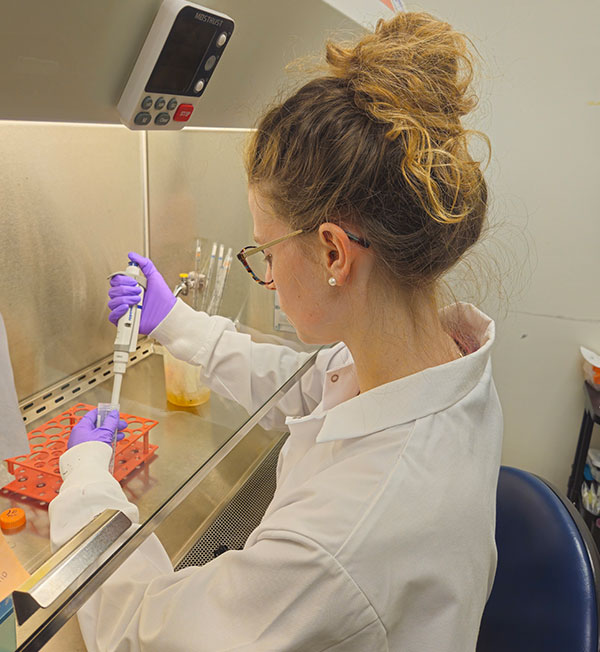Lay Science Writing Competition 2024: Understanding graft versus host disease (GvHD)
Wednesday, December 04, 2024 Katerina Rosenflanz
Our partnership with the Centre for Blood Research (CBR) at the University of British Columbia is helping to train the next generation of researchers in transfusion science. This blog post highlights just some of the achievements in education, training or knowledge mobilization accomplished by CBR trainees.
Canadian Blood Services 2024 Lay Science Writing Competition offered in partnership with the Centre for Blood Research (CBR) provides research trainees an opportunity to exercise and enhance their science communication skills by sharing their research with lay audiences. The competition was open to research trainees in the broad Canadian Blood Services research network – including trainees that are directly funded by Canadian Blood Services, in laboratories that receive funding from Canadian Blood Services, and at the Centre for Blood Research in Vancouver. In this blog, Katerina Rosenflanz, the author of the first-prize winning entry, provides some behind-the-scenes insights into the preparation of her submission. The full entry text is also shared below.

Why did you choose to participate in the competition this year?
Katerina: I have always loved to write, and this competition was a great opportunity for me to practice writing about my research for a broad audience! I’m usually reading or writing academic articles for my studies, so it’s refreshing to be able to write with a more expressive style while explaining what I’ve been working on.
Also, my parents always told me from a young age that “you’ll never know unless you try”. When I saw the competition posting, I decided to listen to them for once and give it a shot!
The theme this year was “Connecting science with society”; what did this theme mean to you?
Katerina: Coming from an engineering background, writing and communication skills were not a huge priority. It’s easy to assume that everyone has the same background, and to explain research in a way that makes sense in our heads. It’s a bit more challenging—but equally as important-- to be able to share our work and its significance with a larger community in simpler terms. By doing so, we can also gain valuable feedback from experts in other areas, as well as from people directly affected by the research!
The Centre for Blood Research at UBC is a great place to connect science with society, as there’s a diverse group of doctors, scientists, and engineers working together on blood-related research. Everyone at the CBR is passionate about making an impact in the clinic!
Did the writing process help you learn or discover something new about your research?
Katerina: The writing process helped me work on communicating a very complex topic in a more concise and clear way. It was helpful for me to ask myself what our main objectives are, as well as the potential impact of the project. I hope to expand awareness about GvHD through this competition!
What tips would you share with others who are writing about research for lay audiences?
Katerina: While writing, I tried to draw an analogy that readers could picture and follow throughout the piece. This makes the research concept more accessible. I also imagined I was explaining my research to friends or family-- what are the key takeaway points? What question am I trying to answer? Why does the research matter?

Read the prize-winning entry in its entirety below...
A fire from within: Understanding graft versus host disease (GvHD)
You may have heard before about “finding a match” for patients undergoing a kidney transplant. But regardless of what you might initially think, doctors aren’t looking for a love match for their patients—actually, they are looking at specific markers that identify the kidney as being biologically compatible with the patient. The closer the match is between donor and recipient, the lower the likelihood is of the organ being rejected by the patient’s body.
A similar process of matching is followed before bone marrow transplantations, used to treat diseases such as leukemia. By looking at tiny proteins called Human Leukocyte Antigens, doctors can try to choose which donor’s cells will work best for the cancer patient. But even when doctors use their best match-making skills, sometimes things can still go wrong.
Bone marrow transplants have millions of healthy stem cells that help your body produce blood cells. Lurking amongst those healthy stem cells, though, are the donor’s T cells (a type of white blood cell). In the donor, they powerfully protect from infection and even kill tumor cells. But when these cells find a new home in the individual receiving the transplant, the T cells take on a much more malicious role. Confused by the recipient’s unfamiliar cells, they become arsonists determined to destroy any potential threats.
Thus begins a small, invisible fire within the patient, also known as graft versus host disease (GvHD). Activated T cells attack the patient’s skin, gastrointestinal tract, and liver. They release a barrage of signaling proteins, called cytokines, which further cause inflammation. As the disease progresses, the fire begins to spread to the other organs, including the lungs and eyes. Depending on the severity of the damage, the patient may die.
Interestingly, not all bone marrow recipients develop GvHD, with incidence rates up to 80%. As a Masters student, I am trying to understand why—what types of cells are specifically responsible for the start of the fire, and what proteins does each type send to other cells in order to cause damage to tissues and organs? By looking at cells individually using powerful tools that allow me to even analyze the genetic makeup of each cell, I hope to gain further insight into the classes of GvHD and how to spot—and put out—the fire early enough to save vulnerable individuals. This research has the potential to aid those already suffering from cancer to have more successful outcomes from bone marrow transplants, and to alleviate anxiety for the patients and their loved ones about developing GvHD.
About the author:
Katerina's research focuses on assay development for GvHD biomarker discovery. She hopes that the assay will also be utilized for early detection of other immune diseases in the future. In her free time, Katerina likes to be outside running, cycling or hiking and also enjoys reading and knitting.
Canadian Blood Services – Driving world-class innovation
Through discovery, development and applied research, Canadian Blood Services drives world-class innovation in blood transfusion, cellular therapy and transplantation—bringing clarity and insight to an increasingly complex healthcare future. Our dedicated research team and extended network of partners engage in exploratory and applied research to create new knowledge, inform and enhance best practices, contribute to the development of new services and technologies, and build capacity through training and collaboration. Find out more about our research impact.
The opinions reflected in this post are those of the author and do not necessarily reflect the opinions of Canadian Blood Services nor do they reflect the views of Health Canada or any other funding agency.
Related blog posts
Canadian Blood Services 2024 Lay Science Writing Competition offered in partnership with the Centre for Blood Research (CBR) provides research trainees an opportunity to exercise and enhance their science communication skills by sharing their research with lay audiences. This write-up by Drs. Chaahat Singh and Giorgia Caspani, postdoctoral fellows in the lab of Dr. Wilfred Jeffries at the Centre for Blood Research, claimed second prize in this year’s competition!
Canadian Blood Services 2024 Lay Science Writing Competition offered in partnership with the Centre for Blood Research (CBR) provides research trainees an opportunity to exercise and enhance their science communication skills by sharing their research with lay audiences. Read Mahsa Yazdanbakhsh’s description of her research as a PhD candidate in the lab of Dr. Jason Acker; the write-up claimed third prize in this year’s competition.
The 2024 Canadian Blood Services’ Lay Science Writing Competition is open for submissions from research trainees in Canadian Blood Services’ research network until Friday, June 14, 2024. The theme this year is: “Connecting science with society”. Additional competition details available in this post!


